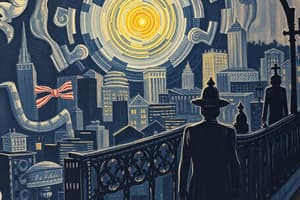Podcast
Questions and Answers
What was the significance of Shuffle Along in the 1920s?
What was the significance of Shuffle Along in the 1920s?
Who skyrocketed to fame in the second act of Shuffle Along?
Who skyrocketed to fame in the second act of Shuffle Along?
Which composer and performer duo were part of Shuffle Along?
Which composer and performer duo were part of Shuffle Along?
Who were part of the orchestra for Shuffle Along?
Who were part of the orchestra for Shuffle Along?
What kind of show was Shuffle Along described as?
What kind of show was Shuffle Along described as?
Who was merely in the chorus of Shuffle Along?
Who was merely in the chorus of Shuffle Along?
What is the Bamboo Inn known for?
What is the Bamboo Inn known for?
Where do Harlem people go to dance without attending a cabaret?
Where do Harlem people go to dance without attending a cabaret?
What is the Savoy known for?
What is the Savoy known for?
What is the price for spending twelve hours at the Savoy?
What is the price for spending twelve hours at the Savoy?
What is suspended from the center of the ceiling at the Bamboo Inn?
What is suspended from the center of the ceiling at the Bamboo Inn?
What role do hostesses play at the Savoy?
What role do hostesses play at the Savoy?
Which establishment is described as the place to see 'low Harlem'?
Which establishment is described as the place to see 'low Harlem'?
What are the colored spotlights at the Bamboo Inn described as doing?
What are the colored spotlights at the Bamboo Inn described as doing?
What does Wallace Thurman's text focus on?
What does Wallace Thurman's text focus on?
What was the Cotton Club's policy towards ordinary Negroes?
What was the Cotton Club's policy towards ordinary Negroes?
Who hosted extravagant parties attended by white elites?
Who hosted extravagant parties attended by white elites?
What type of club was the Sugar Cane Club?
What type of club was the Sugar Cane Club?
What was the Glory Hole?
What was the Glory Hole?
What type of plays were featured on Broadway during this time?
What type of plays were featured on Broadway during this time?
Who appeared in blackface in the play 'Scarlet Sister Mary'?
Who appeared in blackface in the play 'Scarlet Sister Mary'?
Which type of people frequented the Bamboo Inn?
Which type of people frequented the Bamboo Inn?
Who opened up churches for white tourists in Charleston?
Who opened up churches for white tourists in Charleston?
'The Sugar Cane Club had a narrow space for seating and dancing, with an unsophisticated Negro jazz orchestra.' This statement implies that the Sugar Cane Club was:
'The Sugar Cane Club had a narrow space for seating and dancing, with an unsophisticated Negro jazz orchestra.' This statement implies that the Sugar Cane Club was:
'The Glory Hole was an unembellished room, featuring a piano, chairs and a library table.' This description indicates that the Glory Hole was:
'The Glory Hole was an unembellished room, featuring a piano, chairs and a library table.' This description indicates that the Glory Hole was:
What kind of restaurants were the Bamboo Inn and the Sugar Cane Club?
What kind of restaurants were the Bamboo Inn and the Sugar Cane Club?
How were Negro authors' books being published during this time?
How were Negro authors' books being published during this time?
Flashcards are hidden until you start studying
Study Notes
- Langston Hughes was thrilled by the cultural influence of the Negro vogue in Harlem during the 1920s.
- White people flocked to Harlem, packing expensive clubs like the Cotton Club.
- The Cotton Club had a Jim Crow policy, welcoming only celebrities and not allowing ordinary Negroes.
- Harlem Negroes and ordinary people resented the white influx, feeling like they were being objectified.
- Harlem was an upper-crust social scene, attracting white celebrities and royalty to parties.
- A'Lelia Walker, a Negro heiress, hosted extravagant parties attended by white elites.
- Harold Jackman, a school teacher, attended a yacht party hosted by a banker.
- Charleston preachers opened up churches for white tourists and there were hits plays on Broadway with all-Negro casts.
- Negro authors' books were published more frequently and with greater publicity than ever before.
- White writers were more successful in writing about Negroes commercially than Negroes writing about themselves.
- Ethel Barrymore appeared in blackface in a popular play, "Scarlet Sister Mary."
- Harlem's nightlife was a mix of rough and ready cabarets and more sophisticated clubs.
- The Sugar Cane Club was a small, subterranean cabaret for the rougher, more primitive crowd.
- The Sugar Cane Club had a narrow space for seating and dancing, with an unsophisticated Negro jazz orchestra.
- The Glory Hole was a "dive" or social club in a damp basement, frequented by unskilled laborers and their women.
- The Glory Hole was an unembellished room, featuring a piano, chairs and a library table.
- The Bamboo Inn was a Chinese-American restaurant and jazz club, frequented by select Negro Harlem for debutante parties and society events.
Studying That Suits You
Use AI to generate personalized quizzes and flashcards to suit your learning preferences.


